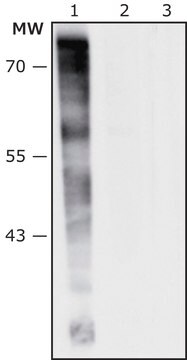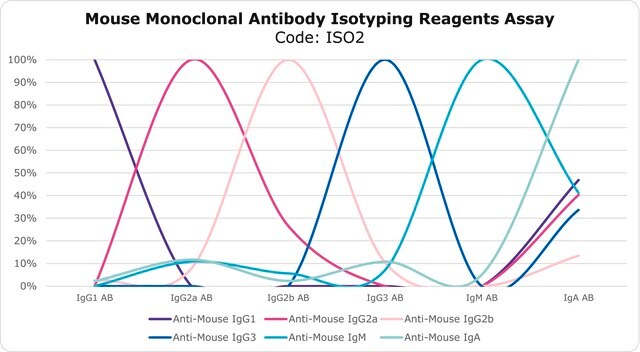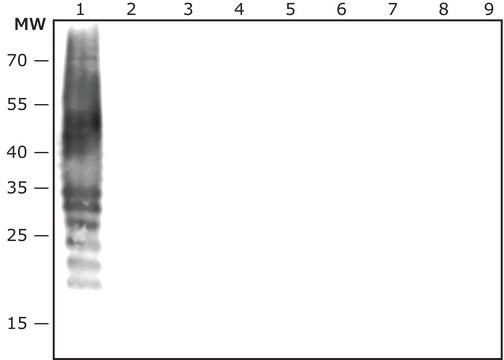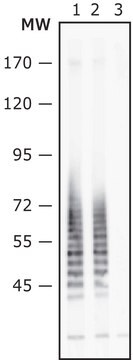SAB4200868
Anti-Enterococcus faecalis antibody produced in rabbit
IgG fraction of antiserum
Sign Into View Organizational & Contract Pricing
All Photos(2)
About This Item
UNSPSC Code:
12352203
NACRES:
NA.43
Recommended Products
Quality Level
form
liquid
species reactivity
(Enterococcus faecalis)
concentration
~1 mg/mL
shipped in
dry ice
storage temp.
−20°C
target post-translational modification
unmodified
General description
Enterococcus faecalis is a gram positive, non-motile, facultative anaerobic, coci-shaped bacterium.1,2 It is a commensal bacterium of the human gut and a major opportunistic pathogen in susceptible hosts.1 E. faecalis is the third most common pathogen associated with hospital-acquired infections.2 E. faecalis inhabits the gut in 80% of healthy adultsand is also a part of the oral cavity normal flora in 20% of the adult population. In addition, E. faecalis was also identified in the human urinary tract.1
Specificity
Anti-Enterococcus faecalis antibody recognizes E. faecalis lysate and whole dead bacteria
Application
The antibody may be used in various immunochemical techniques including Immunoblotting. Detection of the E. faecalis bands by Immunoblotting is specifically inhibited by the immunogen.
Biochem/physiol Actions
E. faecalis contributes to the host in several ways, such as, competing with pathogen bacteria and preventing them from reaching the gut epithelia, prevention of intestinal epithelial barrier leakage and provision of protection from pathogens to the young infant through breast milk consumption.1,3-5
Moreover, E. faecalis also has many effects on the immune system that are beneficial to the host, such as, promoting the secretion of anti-inflammatory cytokines IL-10 and TGF-ß and induction of IgA production.1,6,7
However, when the homeostasis in the gut and mucus barrier is disrupted, especially in susceptible individuals such as in inflammatory bowel diseases (IBD) patients, or upon antibiotic administration, E. faecalis might become an opportunistic pathogen. In such case, the bacteria population overgrows and translocates through the mucus barrier to reach the epithelial cells of the gut where it can enter the bloodstream and the lymphatic system and cause severe inflammation.
Moreover, E. faecalis also has many effects on the immune system that are beneficial to the host, such as, promoting the secretion of anti-inflammatory cytokines IL-10 and TGF-ß and induction of IgA production.1,6,7
However, when the homeostasis in the gut and mucus barrier is disrupted, especially in susceptible individuals such as in inflammatory bowel diseases (IBD) patients, or upon antibiotic administration, E. faecalis might become an opportunistic pathogen. In such case, the bacteria population overgrows and translocates through the mucus barrier to reach the epithelial cells of the gut where it can enter the bloodstream and the lymphatic system and cause severe inflammation.
Physical form
Supplied as a solution in 0.01 M phosphate buffered saline pH 7.4, containing 15 mM sodium azide as a preservative.
Storage and Stability
For continuous use, store at 2-8°C for up to one month. For extended storage, freeze in working aliquots. Repeated freezing and thawing is not recommended. If slight turbidity occurs upon prolonged storage, clarify the solution by centrifugation before use. Working dilution samples should be discarded if not used within 12 hours.
Disclaimer
Unless otherwise stated in our catalog our products are intended for research use only and are not to be used for any other purpose, which includes but is not limited to, unauthorized commercial uses, in vitro diagnostic uses, ex vivo or in vivo therapeutic uses or any type of consumption or application to humans or animals.
Storage Class
12 - Non Combustible Liquids
wgk_germany
nwg
flash_point_f
Not applicable
flash_point_c
Not applicable
Choose from one of the most recent versions:
Certificates of Analysis (COA)
Lot/Batch Number
It looks like we've run into a problem, but you can still download Certificates of Analysis from our Documents section.
If you need assistance, please contact Customer Support.
Already Own This Product?
Find documentation for the products that you have recently purchased in the Document Library.
Global Trade Item Number
| SKU | GTIN |
|---|---|
| SAB4200868-100UL | |
| SAB4200868-25UL |
Our team of scientists has experience in all areas of research including Life Science, Material Science, Chemical Synthesis, Chromatography, Analytical and many others.
Contact Technical Service








